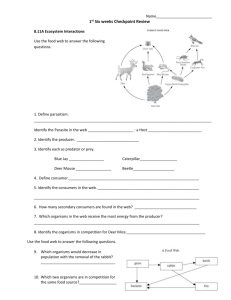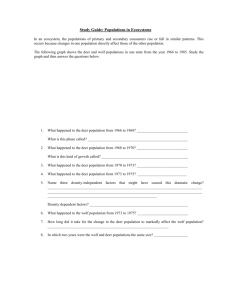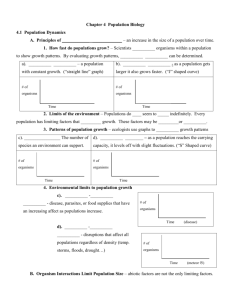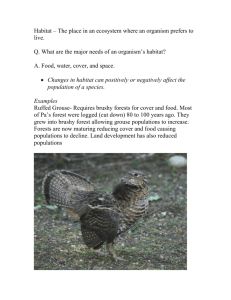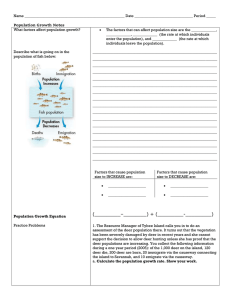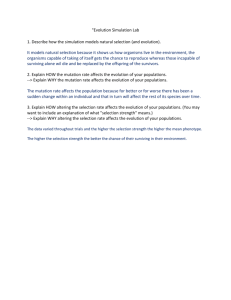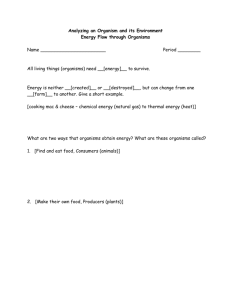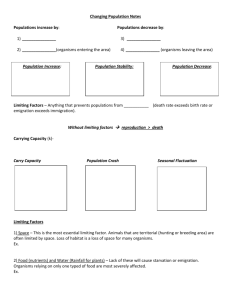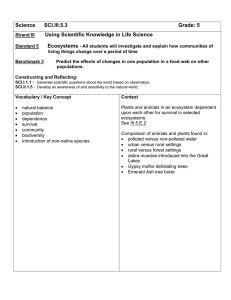General Biology 101
advertisement
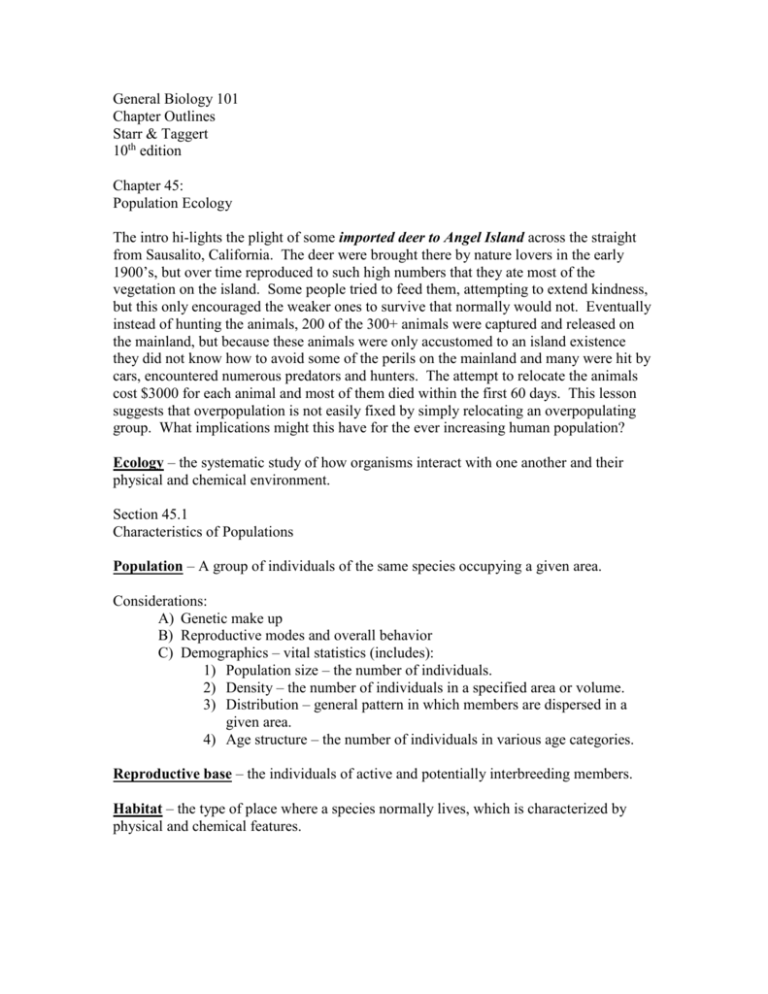
General Biology 101 Chapter Outlines Starr & Taggert 10th edition Chapter 45: Population Ecology The intro hi-lights the plight of some imported deer to Angel Island across the straight from Sausalito, California. The deer were brought there by nature lovers in the early 1900’s, but over time reproduced to such high numbers that they ate most of the vegetation on the island. Some people tried to feed them, attempting to extend kindness, but this only encouraged the weaker ones to survive that normally would not. Eventually instead of hunting the animals, 200 of the 300+ animals were captured and released on the mainland, but because these animals were only accustomed to an island existence they did not know how to avoid some of the perils on the mainland and many were hit by cars, encountered numerous predators and hunters. The attempt to relocate the animals cost $3000 for each animal and most of them died within the first 60 days. This lesson suggests that overpopulation is not easily fixed by simply relocating an overpopulating group. What implications might this have for the ever increasing human population? Ecology – the systematic study of how organisms interact with one another and their physical and chemical environment. Section 45.1 Characteristics of Populations Population – A group of individuals of the same species occupying a given area. Considerations: A) Genetic make up B) Reproductive modes and overall behavior C) Demographics – vital statistics (includes): 1) Population size – the number of individuals. 2) Density – the number of individuals in a specified area or volume. 3) Distribution – general pattern in which members are dispersed in a given area. 4) Age structure – the number of individuals in various age categories. Reproductive base – the individuals of active and potentially interbreeding members. Habitat – the type of place where a species normally lives, which is characterized by physical and chemical features. Patterns of Population Distribution: Clumped (most common pattern) groupings of individuals. Uniform - somewhat even distribution of organisms in a given area because of the competition for resources e.g. orchards of trees, creosote bushes. Random – seen only when habitat conditions are uniform, resources are steady. E.g. wolf spiders on the forest floor. Reasons for distribution may include: - Each species is adapted to a limited set of ecological conditions. Social groups can aid in survival and reproduction (availability of mates). Settling of young near parents e.g. saplings of trees. Section 45.2 Elusive Head Count Currently there are about 18 million deer in the U.S., but at the turn of the century (20th) there were only about 1 million. Why the increase? How do scientists estimate population sizes? Such as deer…. 1) Literature search (to determine what is typical). 2) Full count – actual counting of individuals in a given area i.e. a census. 3) Sampling – making an estimate A. Quadrats – sampling areas of the same size and shape such as rectangles or squares in a given area. The count is then extrapolated for larger areas e.g. counties or states. B. Capture-recapture method – used for mobile species e.g. deer. This method uses tagging of a group (of the same species), and then releasing the animals to recapture them at a later time. The ratio of captured and tagged animals is compared to the original set of tagged animals to make an estimate of the overall density. Considerations or potential problems with capture-recapture methods: - - It is assumed that no mortality occurred because of the method. It assumes that no animals left the area. No individuals get overlooked. Assumes random sampling. In reality some animals may become shy or eager to be captured (if bait is involved). Sometimes the marking devise is lost or destroyed thus under representing the sample set. Populations may vary because of seasonal or migratory patterns. Section 45.3 Populations are dynamic meaning they are changing all the time. > Population increase occurs due to births and immigration. > Population decrease occurs due to deaths and emigration. Zero Population growth – an interval when births balance with deaths, no net growth in the population occurs. Per captia – rates per individual, similar to “head counts.” Net reproduction (r) = birth rate – death rate. Birth rate is calculated by taking the number of births and dividing by the total beginning population e.g. 1000 babies born to 2000 mice in a given area = 1000/2000 or 0.5. G = Population growth per a given unit of time. N = Number of population (members) G = rN Exponential growth – the quantity increasing by a fixed percentage in a given interval of time. A “J” shaped pattern. The larger the “reproductive” base of the population, meaning those that are eligible and able to reproduce, the greater will be the expansion in population size during a specified interval. Doubling Size – the length of time it takes for a population to double in size. Deaths will delay but not stop a J shaped curve, assuming the ideal conditions. Biotic Potential – The maximum rate of increase per individual under ideal conditions, i.e. how many individuals could be added to the population if there were no diseases, shortage of resources etc. As long as the per captia birth rate remains even slightly above the per capita death rate, a population can grow exponentially. Section 45.4 Limits on the Growth of Populations Populations under ideal conditions can demonstrate exponential growth, but they never do so indefinitely. Limiting Factor – any essential resource that is in short supply and limits population growth e.g. nutrients, space, refuge, living/nesting quarters etc. Organisms produce wastes and if the population of such organisms is great this can drastically alter/pollute the environment in which they live. Carrying Capacity – refers to the maximum number of individuals of a population (or species) that a given environment can sustain indefinitely. Represented by “K” in formulas related to growth. Figure 45.7 shows an example of reindeer that were introduced onto an island in the Bering Sea, they increased in a J shaped pattern and in just 30 years the population exceeded their food supply (carrying capacity) and the population crashed. Logistic Growth – a pattern that demonstrates a leveling off of the population size. Usually represented as an “S” shaped curve. Formula for growth (accounting for carrying capacity): (K-N) G = r max N * K Where K-N/K is the same as the proportion of resources not yet used. I. Density Dependent Controls Any factor(s) that affect individuals of a population and that vary with the size/density of the population. Examples: > Greater likelihood of mortality in crowded conditions due to disease. Textbook examples: Bubonic Plague Pneumonic plague II. Density Independent Controls Any effect on population that is “independent” meaning not affected by the size/density of the population. Examples: weather, human involvement such as logging thereby affecting non-human organisms, the use of pesticides etc.


